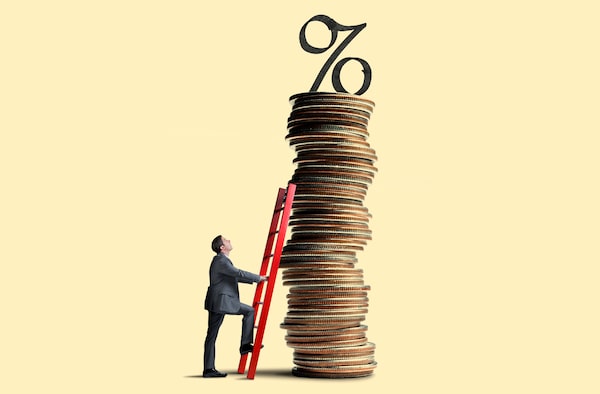
Clients opting for GICs are favoring one-to-three-year maturities as a hedge that interest rates rise further.DNY59/iStockPhoto / Getty Images
Sign up for the new Globe Advisor weekly newsletter for professional financial advisors on our newsletter sign-up page. Get exclusive investment industry news and insights, the week’s top headlines, and what you and your clients need to know.
Guaranteed investment certificates (GICs) are suddenly back in fashion as interest rates rise and investors turn to the comfort of safe, simple fixed income options.
With one-year terms yielding more than 4 per cent, advisors say they are fielding queries from clients who are nervous about the economic outlook. They want to exchange riskier investments for something more secure and plain vanilla GICs fit the bill. They come with the added advantage of Canadian Deposit Insurance Corp. (CDIC) protection, which covers GICs up to $100,000 per institution.
“We have had more participation in GICs in the last two months than in the last three years for good reason,” says Daniel Sacke, portfolio manager and senior investment advisor with The Sacke Wealth Advisory Group at BMO Nesbitt Burns Inc. in Toronto.
Mr. Sacke says the rapid rise in interest rates and gloomy outlook for stocks have put safety of capital top of mind. Clients opting for GICs are favoring one-to-three-year maturities as a hedge that rates rise further.
Another way investors are hedging is through GIC ladders, which spread the maturities over one, two and three years. If at the end of year one, rates are higher, the maturing one-year GIC can be reinvested in a three-year term at the new rate. The following year the same thing can be done with the two-year GICs.
Even so, GIC yields are still well below inflation, which was running at 7.7 per cent on an annual basis in May.
Interest rate comparison website Ratehub.ca is quoting the best one-year GIC rate in a non-registered account at 4.15 per cent, which is a little more than half the rise in prices. That rate is with Equitable Bank, which is an online only lender.
The chartered banks rarely offer rates this good because they compete with their high interest savings accounts. The highest one-year GIC rates at the big banks are at Royal Bank of Canada and Canadian Imperial Bank of Commerce – both pay 3.5 per cent.
Investing in GICs vs. bonds
Dan Hallett, vice president of research and principal at Highview Financial Group in Oakville, Ont., says his firm isn’t fielding a lot of GIC queries because they spend a lot of time creating balanced and diversified portfolios for clients. He says GIC rates are certainly a lot better than they have been, but sees them as less flexible than high quality bonds.
“The raw numbers look good because people haven’t been able to secure these yields for a long time,” he says.
Mr. Hallett notes that a province of Québec bond maturing on September 1, 2031 has a coupon rate (the annual rate of interest) of 1.5 per cent. But it is trading below its face value as rates have increased. This gives the bond a yield to maturity of just over 4 per cent based on recent prices.
A similar Ontario government bond with a coupon rate of 2.25 per cent, maturing on Dec. 2, 2031 is yielding about 4.1 per cent to maturity, he says.
Mr. Hallett says bonds also have a tax advantage, in that part of the return, if it is purchased below par, is a capital gain, which is treated more favourably than the interest income of a GIC.
Konstantin Boehmer, senior vice president and portfolio manager at Mackenzie Investments in Toronto, also sees bonds as more flexible, offering a better return and easier to buy and sell.
Mr. Boehmer co-heads the fixed income team, which oversees the Mackenzie Core Plus Canadian Fixed Income ETF MKB-T. The exchange-traded fund mainly holds provincial and federal government bonds and large corporate credit issuers.
‘Heavy lifting’ of rates ‘already done’
He acknowledges the appeal of GICs after years of low rates and an investor aversion to bonds after a double-digit sell-off earlier this year.
“What speaks to [investors] is that they are pretty safe, you have no market movements, and you have something which is a little bit better than cash,” Mr. Boehmer says. “You can depend on them and they look a lot more attractive than they did a year, two years ago.”
He notes fixed-income investments have faced their worst start to a year since the 1970s, which was caused by the speed and size of rate increases earlier this year. The large movement has made investors skittish, but he says they should be looking ahead rather than in the rearview mirror.
From that perspective, the biggest rate rises may be over because they will slow the economy at best and tip it into recession at worst. That means rates will fall thereafter.
“We’ve seen 50 basis point hikes, we’ve seen 75 basis point hikes and we’re are starting to see an impact on economic activity. That is typically the time when you look at fixed income,” he says.
“A lot of heavy lifting is already done. Has all of it been done? I don’t know. There could be a little bit more to go, yes, for sure. But a lot of [the rate increases] have already happened.”
Adam Mayers is a contributing editor to the Internet Wealth Builder investment newsletter.
For more from Globe Advisor, visit our homepage.